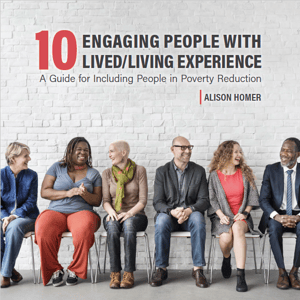 Multi-sectoral collaboration between governments, businesses, non-profit organizations, and people with lived/living experience of poverty has been recognized as a core principle of effective poverty-reduction work since the establishment of Vibrant Communities in 2002.
Multi-sectoral collaboration between governments, businesses, non-profit organizations, and people with lived/living experience of poverty has been recognized as a core principle of effective poverty-reduction work since the establishment of Vibrant Communities in 2002.
People with lived/living experience deeply understand the realities of poverty. Their stories and experiences serve as powerful tools for building compassion, and for disrupting and clarifying a community’s understanding of its root causes and scope. The invaluable expertise of these individuals adds strength and resiliency to poverty-reduction work, and their first-hand knowledge of systemic barriers is invaluable in co-creating innovative solutions to overcome them.
The recognition of people with lived/living experience as context experts alongside government, business, and non-profit counterparts challenges power imbalances and counters the tendency for practitioners in leadership positions to dominate agendas, discussions, and ultimately, decisions.
10 - Engaging People with Lived/Living Experience was written to support the social justice and human rights imperative that people with lived/living experience of poverty must be included as equal partners in the development, implementation, and evaluation of solutions that affect their lives.
“Isolation makes for unhappy communities. To build community, we need to commit to respect and kindness, move from ‘power over’ to ‘power with,’ and create as many places of contact as possible. It is about everyone being empowered. Everybody is worth it.”
- Lee Maidlow, HPE Poverty Roundtable Facilitator & 10 Advisory Committee
Succeeding 10 – A Guide for Cities Reducing Poverty and 10 – A Guide for Businesses Reducing Poverty, this practical guide responds to a strong demand from Cities Reducing Poverty members across Canada who have expressed interest in deepening their practice in meaningfully engaging people with lived/living experience of poverty.
Content for this guide was generated primarily by the 10 Lived/Living Experience Advisory Committee – a team of experts with lived/living experience of poverty and their Cities Reducing Poverty counterparts from across the network. It was also informed by workshops and discussions held at last year’s Cities Innovating to Reduce Poverty events in Vancouver and Peel, and by various Tamarack online learning opportunities, such as community of practice calls and peer-input-process sessions.
10 - Engaging People with Lived/Living Experience attempts to capture the momentum and leading evidence-based practices from the field in a very practical way. It includes:
- A tool for poverty reduction groups to assess their readiness to meaningfully engage people with lived/living experience in poverty reduction
- 10 highly effective ideas for engaging people with lived/living experience, including recommendations on how groups can reflect on, refine, and develop inclusive processes and practices
- 10 stories that illustrate how Cities Reducing Poverty members are meaningfully engaging people with lived/ living experience across Canada.
- 10 really useful resources including tools, guides, case studies, protocols, and policies
- 10 ways for groups to get started
Download 10 - Engaging People with Lived/Living Experience.





